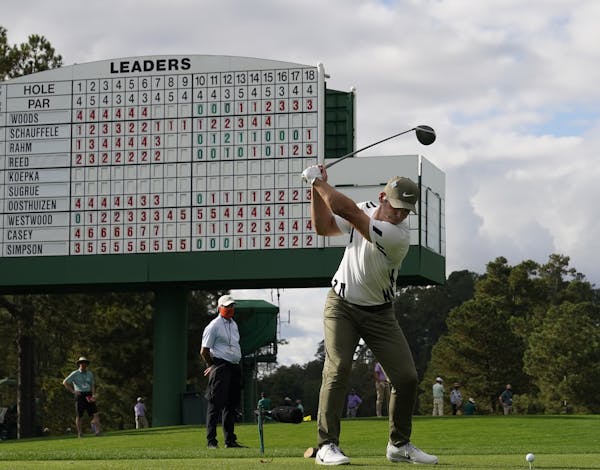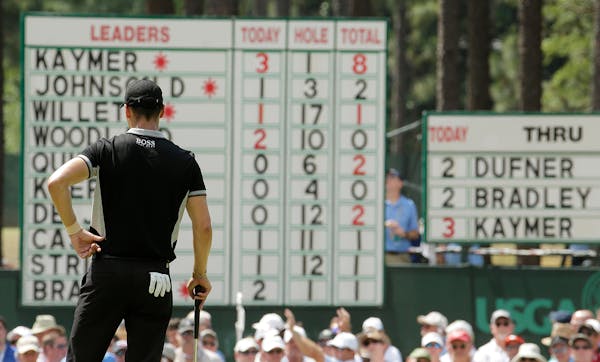AUGUSTA, GA. – The Masters, in normal times, is a sensory experience.
A million shades of green contrasting with blooming azaleas. Sun and shadow. Roars, gasps and golf claps. Undulating hills, towering pines and too-perfect-to-be-real greens. Pimento cheese and cold beer.
On Thursday, the 2020 Masters commenced, and there were no fans or flora. Ochres and burnt oranges replaced the splashes of red, and the roars were absent, meaning a player could bend over a putt on No. 9 and hear only sirens screaming on Washington Road.
"I chipped in on 1 — no claps," Webb Simpson said. "Normally there would be a nice roar."
You could stand beside the seventh green and, with no crowds or bleachers in the way, see the second, seventh, 15th and 17th greens and the third, eighth and 16th tee boxes, and you needed that view to have a chance to see all of the players who still have a chance to win after the first round.
"It felt weird," Patrick Reed said. "You could see through the trees. You could see parts of the course that you usually don't see."
After days spent anticipating Bryson DeChambeau's aerial assault on Augusta National, a strange but strong group rose on the leaderboard by providing a reminder:
Power players don't always win The Masters. Sometimes, the best iron players and putters win, even if they have to hit longer clubs into the greens.
After a long morning rain delay that kept some players from finishing their first round, Paul Casey took the lead with a 7-under 65, two shots better than Simpson, Xander Schauffele and Justin Thomas, who finished just 10 holes before night fell.
Tiger Woods was one of eight players to finish 4 under, along with fellow Masters winners Adam Scott and Reed.
As inviting as Augusta National's par-5s are for big hitters, the course requires precision shots into the greens, and that's why the longest hitters don't always win here.
The past five champions: An aging Woods who won because of his iron play; Reed; an aging Sergio Garcia; Danny Willett; and short-hitting Jordan Spieth.
Before that, Bubba Watson won two in three years by blending power with creative shot-making. The shot that defined his victory was a hooked sand wedge from deep in the woods.
Woods matched the best first round of his Masters career, then said he noticed a drone flying around the course.
"It's a year of firsts," he said. "There's no patrons, no roars. ... That's kind of the way this entire year has been. The fact that we're able to compete for a Masters this year, considering all that's been going on, it's a great opportunity for all of us."
Thursday, DeChambeau made a double-bogey 7 on the 13th hole but rallied to finish at 2 under, leaving himself within reach of the leaders but knowing that his distance won't matter if he can't hit it straight.
"This golf course, as much as I'm trying to attack it, it can bite back," DeChambeau said. "It's still Augusta National, and it's the Masters. It's an amazing test of golf no matter what way you play it. I tried to take on some risk today."
Former Gopher Erik Van Rooyen birdied his first hole and was 1 under after 13 holes, but continually rubbed his lower right back.
DeChambeau headlined the day's most intriguing threesome, starting on No. 10 with Jon Rahm and Louis Oosthuizen.
DeChambeau uses a violent, single-plane swing.
Rahm is a different kind of power player who employs a remarkably short and quick backswing. Oosthuizen has one of the best swings in the game, a fluid, seemingly effortless motion.
Oosthuizen shot a 68 and Rahm a 69, so the threesome will be worth watching again on Friday.
When they arrived on the 10th tee Thursday morning, they went through the ritual of telling their playing partners the brand and number of their ball, so there wouldn't be any confusion.
"Don't worry about it," Rahm said to DeChambeau. "You won't be in the same area code."
DeChambeau hit it longer. Today, he'll try to hit it straighter.
Jim Souhan's podcast can be heard at TalkNorth.com. On Twitter: @SouhanStrib. • jsouhan@startribune.com

Souhan: This is KAT's chance to prove Flip Saunders was right

Souhan: Why Tiger Woods should keep swinging
Souhan: Scheffler wins Masters again, shows what makes him special
Morikawa falters in final round at Masters



